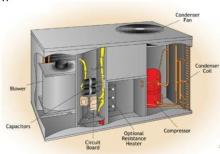Mechanical systems & lighting
Moving Beyond Faith Based Ventilation
We all know that increasingly tight buildings require reliable and effective ventilation systems, not only for occupant comfort and safety but also for building durability. As with any mechanical system, the efficacy of ventilation can be compromised by a number of factors, including design flaws, improper installation, inadequate maintenance and operator error—some of which can only be caught through post-installation testing and ongoing monitoring. The presenters will share strategies for avoiding problems in the first place, as well as for identifying and correcting common problems that may arise after installation and commissioning.
Has the LED Revolution Caught the Fluorescent Tube?
For decades, the straight-tube fluorescent lamp has been top in efficiency and ubiquitous in indoor lighting. Justifiably, the "four-footer" is one of the last lighting types to be displaced in the LED Revolution. But under what circumstances is replacement warranted, and with what? Many are blithely retrofitting one-for-one with LED tubes and kits, achieving dramatic energy cuts, but with insufficient regard for technical, lighting, and safety considerations. Meanwhile, the line between retrofit and new-construction is blurring: code now requires that if 50% of lighting is replaced, then the space must meet strict W/sf and controls requirements. New LED fixtures can now exceed fluorescent in energy efficiency in numerous applications. The best of smart, energy-sophisticated LED lighting, offers responsible, deep savings, and can become much more the norm. With the advanced LED Revolution comes the need for more technical know-how.
What should be done with this house?
What will your existing house look like in the year 2050, if it’s to be part of the solution to the energy and environmental issues we face rather than a continuing part of the problem? What’s the pathway to get it there over time – how might a “phased retrofit” break down into logical, cost-effective steps? In this workshop, two long-time practitioners (and homeowners) will lead the group through a series of case studies to develop master plans for a range of houses. We’ll be looking not just at the homes and their existing internal systems, but also the various external systems and networks the homes participate in – social, transportation, legal and zoning, energy, natural, etc. Participants will be encouraged to submit their own or clients’ homes to the workshop leaders in advance to be prepared as case studies for group discussion. This workshop is open to homeowners and professionals both.
The True Performance of Your Hidden HVAC Equipment
How well does central ventilation equipment actually perform? VEIC and CLEAResult have respectively conducted field monitoring of Roof Top Units in commercial/institutional buildings and central Energy Recovery Ventilators in multifamily buildings. The outcomes? Although in certain cases not as bad as one would predict, this equipment is often underperforming, neglected, misunderstood, and installed and/or operated incorrectly. Come and learn more about our findings, how to improve current performance, and alternative design ideas to do it differently next time.
How We Sleep at Night - Energy Metrics and Decision Making in Residential Design
PHI stands by 4.75kbtu/sq ft/yr for AHD. PHIUS has recently reworked its performance standard. Energy Star now has Version III. Living Building Challenge requires net zero. Green building standards require differing guidance on annual heat demand and peak load. Learn from long time practitioners with experience in climate zones 5, 6 and 7 as they discuss their sweet spots for appropriate metrics in peak load and AHD. Laugh while the moderator mocks, tugs and cajoles the experts while teasing out the answers to life’s persistent questions (according to energy geeks).
Innovation Drives Operations
Discussion of demand management, battery, elevator technologies - all new ways to manage energy usage in buildings that result in real savings to the owner/tenants.
Making Money by Saving Energy
Do all major capital improvements result in better buildings with lower operating costs, better energy management strategies and improved data collection? This panel will discuss the changes made throughout their portfolios to improve NOI, reduce maintenance costs and improve operations, and present the challenges associated with planning for new technologies and staff training so savings can be realized.
The Building Process as Infrastructure
Every building is tied to a series of infrastructure systems through government, wires, cables, energy, and humans. In this session an architect examines the "meta-infrastructure" that buildings nestle into.
Water: Life Blood of Our Infrastructure
NYC uses about a billion gallons of water per day, and the system that delivers it to our tap is both vast and frail, as is the system to dispose of and reuse our water. Water costs many owners more than energy, and sometimes property taxes. Learn about the system, NYCDEP incentives to reduce usage, successful retrofit projects, and the current and future state of NYC’s sewer system.
Demand Response Strategies
This session will explore the incorporation of techniques to increase performance in utility-based energy programs and to draw insights from current Demand Response (DR) uses in New York City. Speakers will review the benefits, concerns, and solutions encountered in actual DR projects, successful DR integration at one of the City’s well-known landmark buildings, going beyond traditional building efficiency initiatives during design and construction, and including backup power sources to ensure grid reliability.



